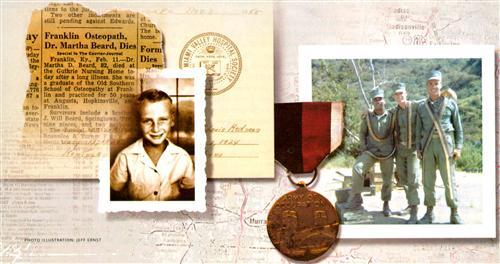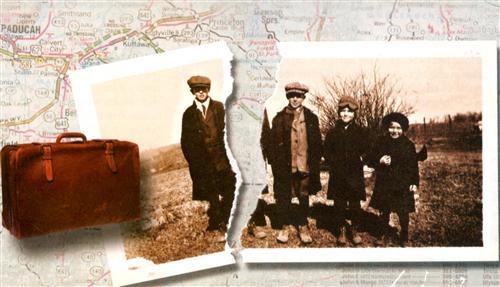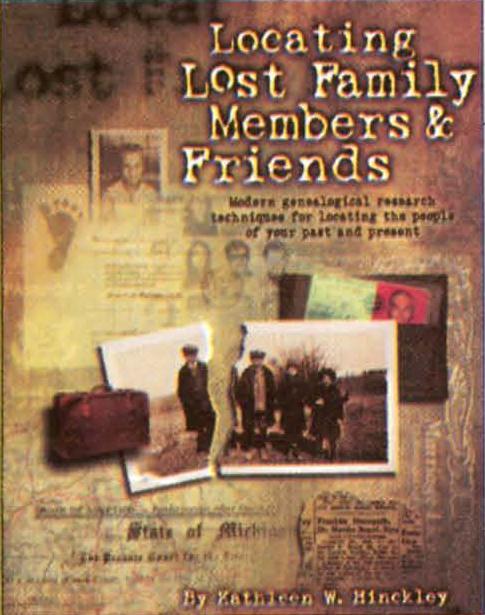Sign up for the Family Tree Newsletter Plus, you’ll receive our 10 Essential Genealogy Research Forms PDF as a special thank you!
Get Your Free Genealogy Forms
"*" indicates required fields
Television talk shows often dramatize the reunion of family members or friends. You know the scene: touching stories, emotional hugs, an abundance of tears.
The reunited families have similar stories. They searched for years and had given up hope of finding their parent, child or sibling. The impression is that finding a long-lost family member is nearly impossible unless you’re a private investigator or specialist in locating persons.
But you don’t have to be Sam Spade or V.I. Warshawski to track down lost pieces of your past. Finding someone can be difficult, but in most cases, you can do it yourself with some patience and tenacity. You can be your own detective and find a classmate, military buddy, first love or missing relative.
Beginning your search
The first step is to write down everything you know about the person you want to locate. And I mean everything. Every detail is important and can make a difference in your research. Use this checklist to jog your memory:
• What’s their full name, including middle name and nickname?
• What’s their approximate age or, better yet, their exact birth date? If you don’t have the exact date, maybe you know the birthday, such as January 10, or even just the month.
• Where were they born?
• When did you see them last? Think hard about the date, as we often miscalculate the number of years.
• What’s their last known address (include date) or telephone number?
• Who are their parents or siblings and where did they live?
• Where did they go to high school and/or college? Did they graduate?
• Who did they marry? Did they have children? Did they divorce? If so, do you have any specifics on names of spouses or children or on dates?
• Were they in the military? If so, what branch and where did they serve?
• Who were their employers, or what was their type of occupation?
Once you’ve compiled a list of known facts, the next step will he to fill in the blanks by researching public records. For example, you may know that the person had been married, but you can’t remember the name of the spouse, nor do you know if they may have divorced. A search of the local marriage and divorce records may produce new information. If you have a last-known address, but don’t know how long they stayed there, a search of city directories may produce address changes or give new employment data. Crisscross directories (arranged by street address rather than alphabetical by name of resident) will give you names of neighbors to interview.
Finding someone is an ongoing process of gathering information that provides clues to gather yet more information. The more you know about a person, the better your odds of finding them. If, for example, you are searching for John White, the odds won’t be good if all you know is that all-too-common name. But if you can determine his middle name or initial, the name of his spouse, the type of employment he may have, or his age, your success rate will increase dramatically.
What’s in a name? Answers!
Like “John White,” so much depends on the last name of the person you’re looking for. Uncommon surnames open additional research possibilities that aren’t possible with ordinary names.
Take the case of how one actual adoption mystery was solved. An adoptee, born in Colorado, knew his birth mother’s name and approximate age. He didn’t know where the birth mother was born, nor did he have any other information about her family. But her surname was very unusual. Checking the Social Security Death Index, he discovered that at least 80 percent of individuals with that particular surname had died in Michigan. A nationwide search of a telephone database gave similar statistics (you can search a collection of phone and address databases, totaling hundreds of millions of names, at <www.familytreemagazine.com>). So he decided to concentrate his search in Michigan. After two hours of telephone interviews of people sharing this unusual surname, the adoptee identified relatives of the birth mother living in Michigan. They provided her current address in Colorado. She turned out to be a widow who hadn’t given birth to any other children. Mother and son were reunited the next day.
Spelling counts with surnames, too, obviously. If the name is spelled correctly in an index, but you’re misspelling it, you won’t find the reference — and vice versa.
For example, in another case, a gentleman willed $10,000 to his co-worker, but misspelled the name in his will. Upon his death and distribution of the estate, the attorney was unable to locate the individual because he was checking telephone directories and real estate records with the incorrect spelling. It was only after considerable research in public records that he determined the correct spelling and consequently located the individual.
The way to avoid spelling traps is to prepare a list of spelling variants and use the list every time you view an index. For example, spelling variations for the surname Kaiser would include Kayser, Reiser, Riser or Kizer.
Take the same thorough approach with given names, which can also appear in several styles — for instance, with or without a middle name, middle name only, nickname or just initials. If you were searching for a William Andrew Parker, public records and indexes might have him under any of these styles:
Continue to keep an open mind while searching indexes. It’s easy to be positive you have the correct spelling when in fact, you don’t.
Take the case of one birth mother who was helping her son locate the birth father, and had excellent identifying information. Since she’d been engaged to the father, she knew his full name, month of birth (exact day was unknown and year was questionable), jobs he’d held and other miscellaneous information. When they found an individual who fit the profile, but had a surname spelled slightly differently, she insisted that it couldn’t be the father: “I was going to marry the man. I certainly know how to spell his name!” She was wrong. The individual with the slightly different surname spelling turned out indeed to be the father.

The city directory is your most valuable resource for locating lost family and friends. It can provide important identifiers for tracking people further, such as full name, exact address, name of spouse, employment data and names of relatives at the same address.
City directories have been published for more than 150 years in nearly all cities in the US. They are similar to telephone directories, but contain the extra data listed above. City directories are issued annually in most cities; smaller communities may go three to five years between publications. Chicago, New York City and Los Angeles discontinued publication of city directories in 1928-29, 1933-34 and 1942 respectively, because population size made them too unwieldy.
City directory research is more complex than it may appear, requiring slower and more methodical efforts to uncover important data. The directories vary in content from year to year. One year might give the middle name of an individual you’re looking for; another year might list a nickname. One year may list the name of the person’s 21-year-old son who’s attending school; the next year the son has vanished. Make sure you search every possible year and examine every listing for the surname you’re investigating.
The best way to access city directories is to visit a library in the city of interest. If you can’t research in person, try asking the librarian to photocopy pages with the surname you’re researching.
Ask the neighbors
If the person you’re tracking moved, who might know why they moved or where they went? The neighbors! Information obtained from interviewing neighbors can be the breakthrough that you need. They can tell you if the house was sold because there was a job transfer or a divorce. They can tell you what schools the children attended and they may even have the person’s current address and telephone number.
The easiest way to identify neighbors is to use a crisscross directory (sometimes called a householder directory) that organizes people by street address rather than by name. Crisscross directories can be a separate volume from the city directory, or a separate section within the directory itself.
Keep in mind the dates of residence. If the person you’re tracking lived at one address from 1950 to 1960, you want to interview the neighbors from that time period. The directories from 1950-1960 will give you a list of names to compare to the current telephone directory. Telephone only those neighbors who have remained in the neighborhood. If they’ve all moved, you have a new task of locating the neighbors.
Persons who live in apartment complexes aren’t as easy to track. But you’ll be surprised how much an apartment manager might tell you, particularly if your quarry skipped out without paying rent.
Sleuthing online
The Internet is a giant playground for family detectives. The volume of information is mind-boggling and search possibilities are limited only by your creativity and patience. Data is buried deep within some sites, but also easily found in others. Your skills in finding information will increase with experience, so don’t be discouraged if your first attempts are fruitless.
But beware: The Internet is seductive and gives the illusion that all the answers to your family mysteries are only a keystroke away. In reality, the Internet can be an important tool in tracking or locating an individual, but public records located in courthouses, libraries and archives are just as valuable and necessary.
When surfing genealogical Web sites, remember that their focus is primarily pre-20th century. But this doesn’t mean that you won’t find helpful information at these sites. See the box above for a list of popular Web sites to get you started; you can search many of these with a single click using the SuperSearch at the Family Tree Magazine Web site <www.familytreemagazine.com/search>.
Going backward to go forward
Finding a living person sometimes requires going backward one or two generations and researching deceased persons. The probate records, death certificates, Social Security applications and obituaries of the deceased persons will give information about the living.
Genealogy Web sites can help you here, as can the Family History Library in Salt Lake City, Utah, the largest genealogical library in the world. Much of the information housed there can also be accessed at any of the 3,400 Family History Centers located around the world.
Interviewing neighbors can be the breakthrough that you need. They can tell you if the house was sold because there was a job transfer or a divorce, what schools the children attended… and they may even have a current address.
You might think, as many people do, that the Family History Library collects only old records, and that it has no recent records helpful in locating a living person. In fact, the library continues to develop its 20th-century collection to assist people just like you who want to find a living person. It has city directories, funeral home records, marriage and divorce records, genealogies that extend into late 20th century and vital-record indexes. Your local Family History Center can bring this treasure trove of data right into your own hometown.
For a handy chart of 20th-century vital-record indexes that are accessible at the Family History Library (and thus available on loan through your local Family History Center), click on the Family Tree Magazine Web site <www.familytreemagzine.com/articles/fhcvitalrecords.html>.
Books such as Locating Lost Family Members & Friends can help you take the next step.
When you find the person
Once you find the missing person you seek, the next step is contacting him or her. This can be a delicate situation, depending upon the reasons behind the search.
If, for example, you were searching for a former classmate or military buddy, he’ll most likely welcome your contact. But what if you found a child whom you haven’t seen since your divorce 25 years ago? She may rejoice at being found, or she may resent the intrusion into her life.
When you make the contact, whether by correspondence or telephone, the other person will be caught by surprise. Keep in mind that while you’ve been focused on the search for days, months or years, this is brand-new and out of the blue to the person you’ve been looking for. He probably didn’t realize he’d been “lost.” Give the other person time to absorb the information gradually. Be gentle. Be respectful.
After the reunion, celebrate the beginning of a renewed relationship, but also remember to cherish the friends and family who’ve been with you all along and will never be lost.
ADVERTISEMENT



